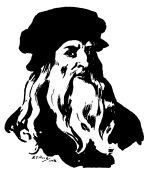
The Project Gutenberg EBook of Leonardo da Vinci, by Maurice W. Brockwell Copyright laws are changing all over the world. Be sure to check the copyright laws for your country before downloading or redistributing this or any other Project Gutenberg eBook. This header should be the first thing seen when viewing this Project Gutenberg file. Please do not remove it. Do not change or edit the header without written permission. Please read the "legal small print," and other information about the eBook and Project Gutenberg at the bottom of this file. Included is important information about your specific rights and restrictions in how the file may be used. You can also find out about how to make a donation to Project Gutenberg, and how to get involved. **Welcome To The World of Free Plain Vanilla Electronic Texts** **eBooks Readable By Both Humans and By Computers, Since 1971** *****These eBooks Were Prepared By Thousands of Volunteers!***** Title: Leonardo da Vinci Author: Maurice W. Brockwell Release Date: March, 2005 [EBook #7785] [Yes, we are more than one year ahead of schedule] [This file was first posted on May 16, 2003] Edition: 10 Language: English Character set encoding: iso-8859-1 *** START OF THE PROJECT GUTENBERG EBOOK LEONARDO DA VINCI *** Produced by Juliet Sutherland, David Widger and the DP Team
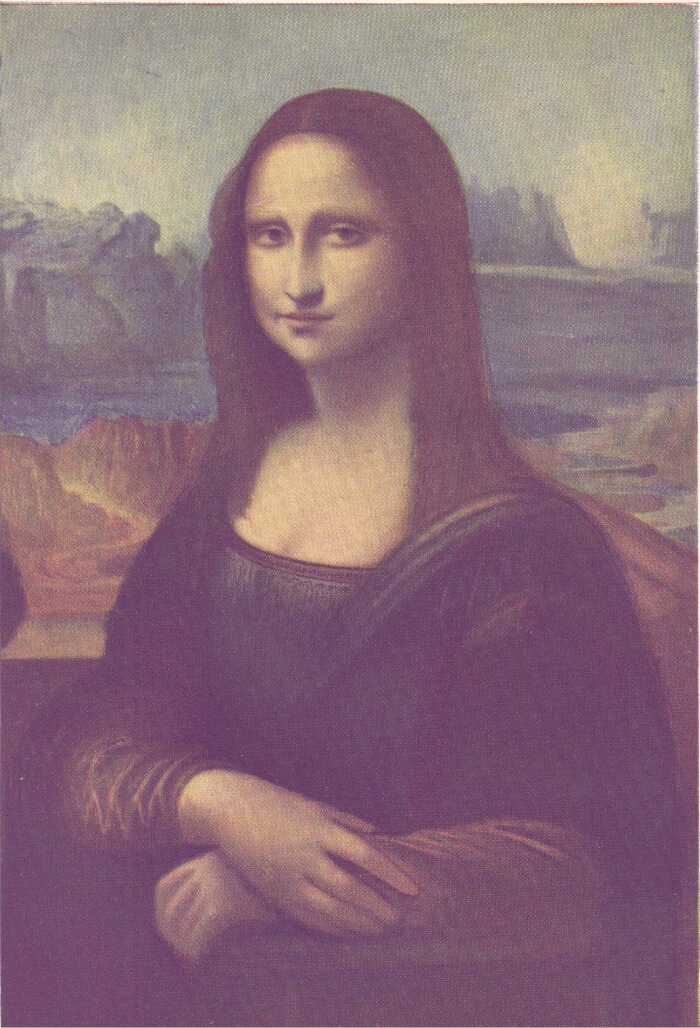
[Plate 1—MONA LISA. In the Louvre.
No. 1601. 2 ft 6 ½ ins. By 1 ft. 9 ins.(0.77 x 0.53)]

"Leonardo," wrote an English critic as far back as 1721, "was
a Man
so happy in his genius, so consummate in his Profession, so
accomplished in the Arts, so knowing in the Sciences, and withal,
so
much esteemed by the Age wherein he lived, his Works so
highly
applauded by the Ages which have succeeded, and his Name and
Memory
still preserved with so much Veneration by the present Age—that,
if
anything could equal the Merit of the Man, it must be the Success
he
met with. Moreover, 'tis not in Painting alone, but in
Philosophy,
too, that Leonardo surpassed all his Brethren of the
'Pencil.'"
This admirable summary of the great Florentine painter's
life's work
still holds good to-day.
His Birth
His Early Training
His Early Works
First Visit to Milan
In the East
Back in Milan
The Virgin of the Rocks
The Last Supper
The Court of Milan
Leonardo Leaves Milan
Mona Lisa
Battle of Anghiari
Again in Milan
In Rome
In France
His Death
His Art
His Mind
His Maxims
His Spell
His Descendants
Plate
I. Mona Lisa
In the Louvre
II. Annunciation
In the Uffizi Gallery, Florence
III. Virgin of the Rocks
In the National Gallery, London
IV. The Last Supper
In the Refectory of Santa Maria delle Grazie, Milan
V. Copy of the Last Supper
In the Diploma Gallery, Burlington House
VI. Head of Christ
In the Brera Gallery, Milan
VII. Portrait (presumed) of Lucrezia Crivelli
In the Louvre
VIII. Madonna, Infant Christ, and St Anne.
In the Louvre
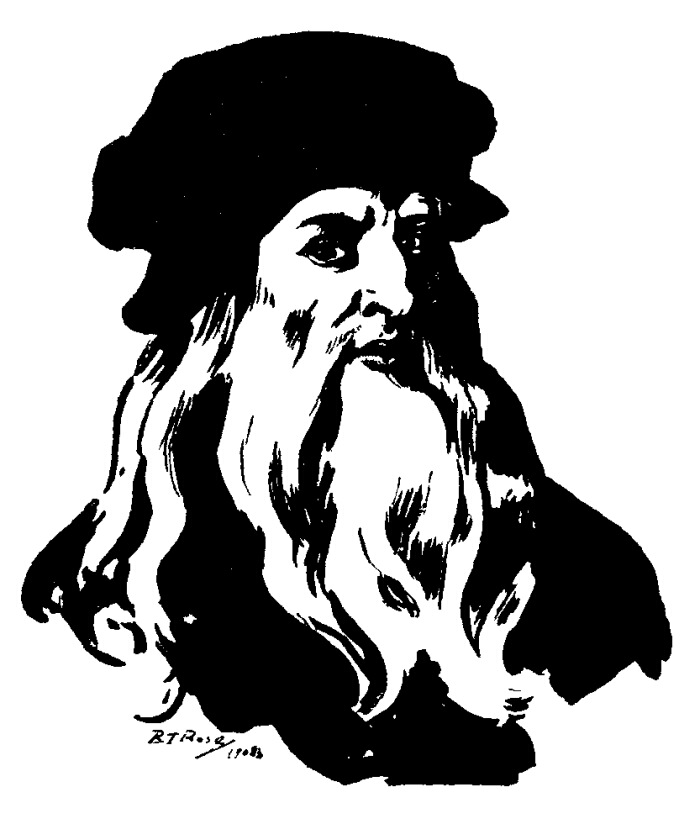
Leonardo Da Vinci, the many-sided genius of the Italian
Renaissance,
was born, as his name implies, at the little town of Vinci, which
is
about six miles from Empoli and twenty miles west of Florence.
Vinci
is still very inaccessible, and the only means of conveyance is
the
cart of a general carrier and postman, who sets out on his
journey
from Empoli at sunrise and sunset. Outside a house in the middle
of
the main street of Vinci to-day a modern and white-washed bust of
the
great artist is pointed to with much pride by the
inhabitants.
Leonardo's traditional birthplace on the outskirts of the town
still
exists, and serves now as the headquarters of a farmer and small
wine
exporter.
Leonardo di Ser Piero d'Antonio di Ser Piero di Ser Guido
da
Vinci—for that was his full legal name—was the natural and
first-born son of Ser Piero, a country notary, who, like his
father,
grandfather, and great-grandfather, followed that honourable
vocation with distinction and success, and who
subsequently—when
Leonardo was a youth—was appointed notary to the Signoria of
Florence. Leonardo's mother was one Caterina, who afterwards
married
Accabriga di Piero del Vaccha of Vinci.
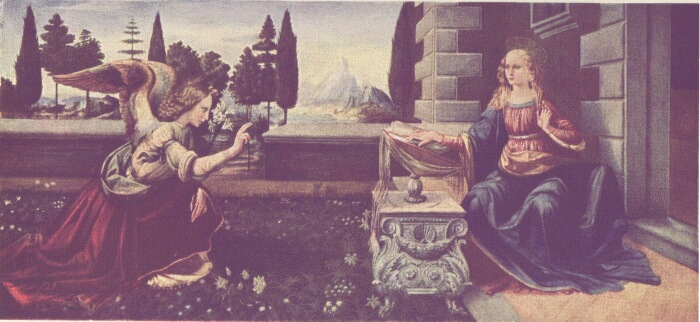
Plate II.—Annunciation In the Uffizi Gallery, Florence. No. 1288. 3 ft 3 ins. By 6 ft 11 ins. (0.99 x 2.18)] Although this panel is included in the Uffizi Catalogue as being by Leonardo, it is in all probability by his master, Verrocchio.]
The date of Leonardo's birth is not known with any certainty.
His age
is given as five in a taxation return made in 1457 by his
grandfather
Antonio, in whose house he was educated; it is therefore
concluded
that he was born in 1452. Leonardo's father Ser Piero, who
afterwards
married four times, had eleven children by his third and fourth
wives.
Is it unreasonable to suggest that Leonardo may have had these
numbers
in mind in 1496-1498 when he was painting in his famous "Last
Supper"
the figures of eleven Apostles and one outcast?
However, Ser Piero seems to have legitimised his "love child"
who very
early showed promise of extraordinary talent and untiring
energy.
Practically nothing is known about Leonardo's boyhood, but
Vasari
informs us that Ser Piero, impressed with the remarkable
character of
his son's genius, took some of his drawings to Andrea del
Verrocchio,
an intimate friend, and begged him earnestly to express an
opinion on
them. Verrocchio was so astonished at the power they revealed
that he
advised Ser Piero to send Leonardo to study under him. Leonardo
thus
entered the studio of Andrea del Verrocchio about 1469-1470. In
the
workshop of that great Florentine sculptor, goldsmith, and artist
he
met other craftsmen, metal workers, and youthful painters, among
whom
was Botticelli, at that moment of his development a jovial
_habitué_ of the Poetical Supper Club, who had not yet
given any
premonitions of becoming the poet, mystic, and visionary of
later
times. There also Leonardo came into contact with that
unoriginal
painter Lorenzo di Credi, his junior by seven years. He also,
no
doubt, met Perugino, whom Michelangelo called "that blockhead in
art."
The genius and versatility of the Vincian painter was, however,
in no
way dulled by intercourse with lesser artists than himself; on
the
contrary he vied with each in turn, and readily outstripped his
fellow
pupils. In 1472, at the age of twenty, he was admitted into the
Guild
of Florentine Painters.
Unfortunately very few of Leonardo's paintings have come down
to us.
Indeed there do not exist a sufficient number of finished and
absolutely authentic oil pictures from his own hand to afford
illustrations for this short chronological sketch of his life's
work.
The few that do remain, however, are of so exquisite a
quality—or
were until they were "comforted" by the uninspired restorer—that
we
can unreservedly accept the enthusiastic records of tradition
in
respect of all his works. To rightly understand the essential
characteristics of Leonardo's achievements it is necessary to
regard him as a scientist quite as much as an artist, as a
philosopher
no less than a painter, and as a draughtsman rather than a
colourist.
There is hardly a branch of human learning to which he did not
at
one time or another give his eager attention, and he was
engrossed in
turn by the study of architecture—the foundation-stone of all
true
art—sculpture, mathematics, engineering and music. His
versatility
was unbounded, and we are apt to regret that this many-sided
genius
did not realise that it is by developing his power within
certain
limits that the great master is revealed. Leonardo may be
described as
the most Universal Genius of Christian times-perhaps of all
time.
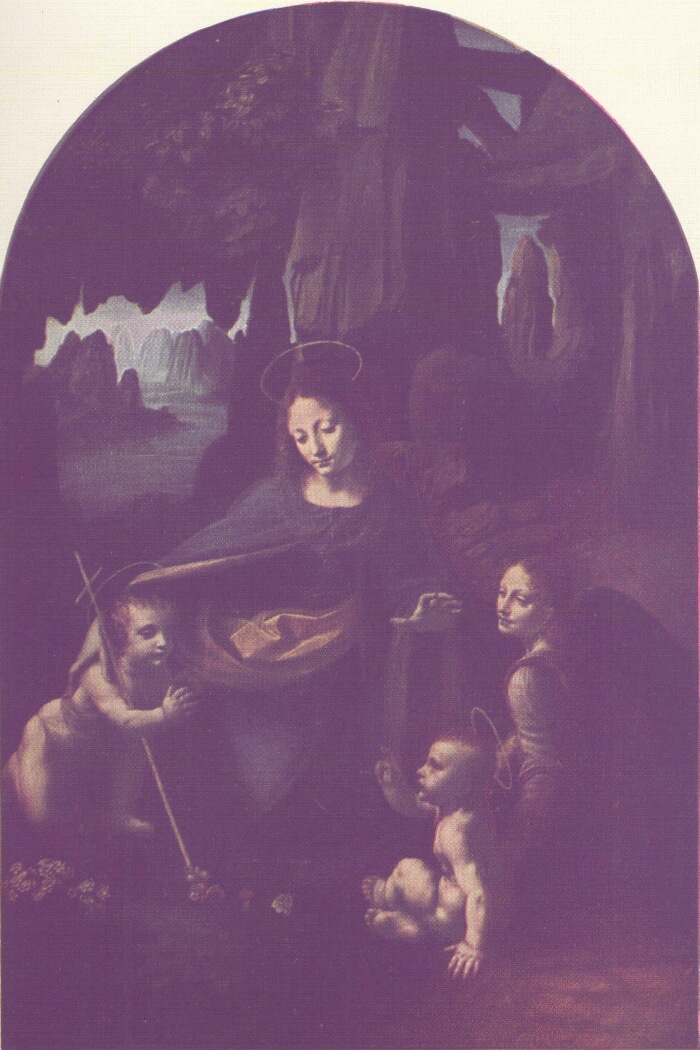
[PLATE III. THE VIRGIN OF THE ROCKS In the National Gallery. No. 1093. 6 ft. ½ in. h. by 3 ft 9 ½ in. w. (1.83 x 1.15)] This picture was painted in Milan about 1495 by Ambrogio da Predis under the supervision and guidance of Leonardo da Vinci, the essential features of the composition being borrowed from the earlier "Vierge aux Rochers," now in the Louvre.]

[Plate II.—Annunciation In the Uffizi Gallery, Florence. No. 1288. 3 ft 3 ins. By 6 ft 11 ins. (0.99 x 2.18)]
To about the year 1472 belongs the small picture of the
"Annunciation," now in the Louvre, which after being the subject
of
much contention among European critics has gradually won its way
to
general recognition as an early work by Leonardo himself. That it
was
painted in the studio of Verrocchio was always admitted, but it
was
long catalogued by the Louvre authorities under the name of
Lorenzo di
Credi. It is now, however, attributed to Leonardo (No. 1602 A).
Such
uncertainties as to attribution were common half a century ago
when
scientific art criticism was in its infancy.
Another painting of the "Annunciation," which is now in the
Uffizi
Gallery (No. 1288) is still officially attributed to Leonardo.
This
small picture, which has been considerably repainted, and is
perhaps
by Andrea del Verrocchio, Leonardo's master, is the subject of
Plate
II.
To January 1473 belongs Leonardo's earliest dated work, a
pen-and-ink
drawing—"A Wide View over a Plain," now in the Uffizi. The
inscription together with the date in the top left-hand corner
is
reversed, and proves a remarkable characteristic of
Leonardo's
handwriting—viz., that he wrote from right to left; indeed, it
has
been suggested that he did this in order to make it difficult for
any
one else to read the words, which were frequently committed to
paper
by the aid of peculiar abbreviations.
Leonardo continued to work in his master's studio till about
1477. On
January 1st of the following year, 1478, he was commissioned to
paint
an altar-piece for the Chapel of St. Bernardo in the Palazzo
Vecchio,
and he was paid twenty-five florins on account. He, however,
never
carried out the work, and after waiting five years the
Signoria
transferred the commission to Domenico Ghirlandajo, who also
failed to
accomplish the task, which was ultimately, some seven years
later,
completed by Filippino Lippi. This panel of the "Madonna
Enthroned,
St. Victor, St. John Baptist, St. Bernard, and St. Zenobius,"
which is
dated February 20, 1485, is now in the Uffizi.
That Leonardo was by this time a facile draughtsman is
evidenced by
his vigorous pen-and-ink sketch—now in a private collection
in
Paris—of Bernardo Bandini, who in the Pazzi Conspiracy of April
1478
stabbed Giuliano de' Medici to death in the Cathedral at
Florence
during High Mass. The drawing is dated December 29, 1479, the
date of
Bandini's public execution in Florence.
In that year also, no doubt, was painted the early and, as
might be
expected, unfinished "St. Jerome in the Desert," now in the
Vatican, the
under-painting being in umber and _terraverte_. Its authenticity
is
vouched for not only by the internal evidence of the picture
itself, but
also by the similarity of treatment seen in a drawing in the
Royal
Library at Windsor. Cardinal Fesch, a princely collector in Rome
in the
early part of the nineteenth century, found part of the
picture—the
torso—being used as a box-cover in a shop in Rome. He long
afterwards
discovered in a shoemaker's shop a panel of the head which
belonged to
the torso. The jointed panel was eventually purchased by Pope
Pius IX.,
and added to the Vatican Collection.
In March 1480 Leonardo was commissioned to paint an
altar-piece for
the monks of St. Donato at Scopeto, for which payment in advance
was
made to him. That he intended to carry out this contract seems
most
probable. He, however, never completed the picture, although it
gave
rise to the supremely beautiful cartoon of the "Adoration of
the
Magi," now in the Uffizi (No. 1252). As a matter of course it
is
unfinished, only the under-painting and the colouring of the
figures
in green on a brown ground having been executed. The rhythm of
line,
the variety of attitude, the profound feeling for landscape and
an
early application of chiaroscuro effect combine to render this
one of
his most characteristic productions.
Vasari tells us that while Verrocchio was painting the
"Baptism of
Christ" he allowed Leonardo to paint in one of the attendant
angels
holding some vestments. This the pupil did so admirably that
his
remarkable genius clearly revealed itself, the angel which
Leonardo
painted being much better than the portion executed by his
master.
This "Baptism of Christ," which is now in the Accademia in
Florence
and is in a bad state of preservation, appears to have been a
comparatively early work by Verrocchio, and to have been
painted
in 1480-1482, when Leonardo would be about thirty years of
age.
To about this period belongs the superb drawing of the
"Warrior," now
in the Malcolm Collection in the British Museum. This drawing may
have
been made while Leonardo still frequented the studio of Andrea
del
Verrocchio, who in 1479 was commissioned to execute the
equestrian
statue of Bartolommeo Colleoni, which was completed twenty years
later
and still adorns the Campo di San Giovanni e Paolo in Venice.
About 1482 Leonardo entered the service of Ludovico Sforza,
having
first written to his future patron a full statement of his
various
abilities in the following terms:—
"Having, most illustrious lord, seen and pondered over the
experiments
made by those who pass as masters in the art of inventing
instruments
of war, and having satisfied myself that they in no way differ
from
those in general use, I make so bold as to solicit, without
prejudice
to any one, an opportunity of informing your excellency of some
of my
own secrets."
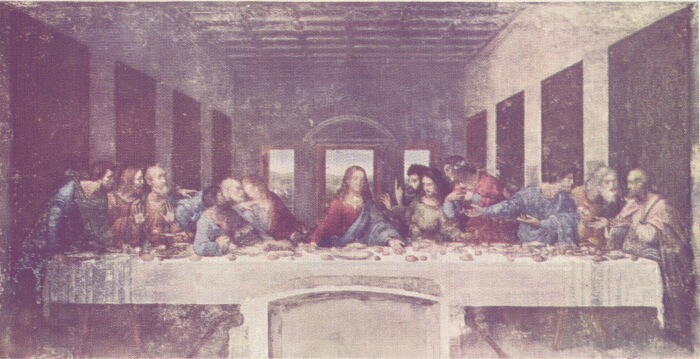
[PLATE IV.-THE LAST SUPPER Refectory of St. Maria delle Grazie, Milan. About 13 feet 8 ins. h. by 26 ft. 7 ins. w. (4.16 x 8.09)]
He goes on to say that he can construct light bridges which
can be
transported, that he can make pontoons and scaling ladders, that
he
can construct cannon and mortars unlike those commonly used, as
well
as catapults and other engines of war; or if the fight should
take
place at sea that he can build engines which shall be suitable
alike
for defence as for attack, while in time of peace he can erect
public
and private buildings. Moreover, he urges that he can also
execute
sculpture in marble, bronze, or clay, and, with regard to
painting,
"can do as well as any one else, no matter who he may be." In
conclusion, he offers to execute the proposed bronze equestrian
statue
of Francesco Sforza "which shall bring glory and never-ending
honour
to that illustrious house."
It was about 1482, the probable date of Leonardo's migration
from
Florence to Milan, that he painted the "Vierge aux Rochers," now
in
the Louvre (No. 1599). It is an essentially Florentine picture,
and
although it has no pedigree earlier than 1625, when it was in
the
Royal Collection at Fontainebleau, it is undoubtedly much earlier
and
considerably more authentic than the "Virgin of the Rocks," now
in the
National Gallery (Plate III.).
He certainly set to work about this time on the projected
statue of
Francesco Sforza, but probably then made very little progress
with it.
He may also in that year or the next have painted the lost
portrait of
Cecilia Gallerani, one of the mistresses of Ludovico Sforza. It
has,
however, been surmised that that lady's features are preserved to
us
in the "Lady with a Weasel," by Leonardo's pupil Boltraffio,
which is
now in the Czartoryski Collection at Cracow.
The absence of any record of Leonardo in Milan, or elsewhere
in Italy,
between 1483 and 1487 has led critics to the conclusion, based
on
documentary evidence of a somewhat complicated nature, that he
spent
those years in the service of the Sultan of Egypt, travelling
in
Armenia and the East as his engineer.
In 1487 he was again resident in Milan as general
artificer—using
that term in its widest sense—to Ludovico. Among his various
activities at this period must be mentioned the designs he made
for
the cupola of the cathedral at Milan, and the scenery he
constructed
for "Il Paradiso," which was written by Bernardo Bellincioni on
the
occasion of the marriage of Gian Galeazzo with Isabella of
Aragon.
About 1489-1490 he began his celebrated "Treatise on Painting"
and
recommenced work on the colossal equestrian statue of
Francesco
Sforza, which was doubtless the greatest of all his achievements
as a
sculptor. It was, however, never cast in bronze, and was
ruthlessly
destroyed by the French bowmen in April 1500, on their occupation
of
Milan after the defeat of Ludovico at the battle of Novara. This
is
all the more regrettable as no single authentic piece of
sculpture
has come down to us from Leonardo's hand, and we can only judge
of his
power in this direction from his drawings, and the
enthusiastic
praise of his contemporaries.
This copy is usually ascribed to Marco d'Oggiono, but some
critics
claim that it is by Gianpetrino. It is the same size as the
original.]

The "Virgin of the Rocks" (Plate III.), now in the National
Gallery,
corresponds exactly with a painting by Leonardo which was
described by
Lomazzo about 1584 as being in the Chapel of the Conception in
the
Church of St. Francesco at Milan. This picture, the only
_oeuvre_
in this gallery with which Leonardo's name can be connected,
was
brought to England in 1777 by Gavin Hamilton, and sold by him to
the
Marquess of Lansdowne, who subsequently exchanged it for
another
picture in the Collection of the Earl of Suffolk at Charlton
Park,
Wiltshire, from whom it was eventually purchased by the
National
Gallery for £9000. Signor Emilio Motta, some fifteen years
ago,
unearthed in the State Archives of Milan a letter or memorial
from
Giovanni Ambrogio da Predis and Leonardo da Vinci to the Duke
of
Milan, praying him to intervene in a dispute, which had arisen
between
the petitioners and the Brotherhood of the Conception, with
regard to
the valuation of certain works of art furnished for the chapel of
the
Brotherhood in the church of St. Francesco. The only logical
deduction
which can be drawn from documentary evidence is that the "Vierge
aux
Rochers" in the Louvre is the picture, painted about 1482,
which
between 1491 and 1494 gave rise to the dispute, and that, when it
was
ultimately sold by the artists for the full price asked to
some
unknown buyer, the National Gallery version was executed for
a
smaller price mainly by Ambrogio da Predisunder the supervision,
and
with the help, of Leonardo to be placed in the Chapel of the
Conception.
The differences between the earlier, the more authentic, and
the more
characteristically Florentine "Vierge aux Rochers," in the
Louvre, and
the "Virgin of the Rocks," in the National Gallery, are that in
the
latter picture the hand of the angel, seated by the side of the
Infant
Christ, is raised and pointed in the direction of the little St.
John
the Baptist; that the St John has a reed cross and the three
principal
figures have gilt nimbi, which were, however, evidently added
much
later. In the National Gallery version the left hand of the
Madonna,
the Christ's right hand and arm, and the forehead of St. John
the
Baptist are freely restored, while a strip of the foreground
right
across the whole picture is ill painted and lacks accent. The
head of
the angel is, however, magnificently painted, and by Leonardo;
the
panel, taken as a whole, is exceedingly beautiful and full of
charm
and tenderness.

Between 1496 and 1498 Leonardo painted his _chef d'oeuvre_,
the
"Last Supper," (Plate IV.) for the end wall of the Refectory of
the
Dominican Convent of S. Maria delle Grazie at Milan. It was
originally
executed in tempera on a badly prepared stucco ground and began
to
deteriorate a very few years after its completion. As early as
1556 it
was half ruined. In 1652 the monks cut away a part of the
fresco
including the feet of the Christ to make a doorway. In 1726
one
Michelangelo Belotti, an obscure Milanese painter, received
£300 for
the worthless labour he bestowed on restoring it. He seems to
have
employed some astringent restorative which revived the
colours
temporarily, and then left them in deeper eclipse than before. In
1770
the fresco was again restored by Mazza. In 1796 Napoleon's
cavalry,
contrary to his express orders, turned the refectory into a
stable,
and pelted the heads of the figures with dirt. Subsequently
the
refectory was used to store hay, and at one time or another it
has
been flooded. In 1820 the fresco was again restored, and in 1854
this
restoration was effaced. In October 1908 Professor Cavenaghi
completed
the delicate task of again restoring it, and has, in the opinion
of
experts, now preserved it from further injury. In addition,
the
devices of Ludovico and his Duchess and a considerable amount
of
floral decoration by Leonardo himself have been brought to
light.
Leonardo has succeeded in producing the effect of the _coup
de
théâtre_ at the moment when Jesus said "One of you
shall betray
me." Instantly the various apostles realise that there is a
traitor
among their number, and show by their different gestures
their
different passions, and reveal their different temperaments. On
the
left of Christ is St. John who is overcome with grief and is
interrogated by the impetuous Peter, near whom is seated
Judas
Iscariot who, while affecting the calm of innocence, is quite
unable
to conceal his inner feelings; he instinctively clasps the
money-bag
and in so doing upsets the salt-cellar.
It will be remembered that the Prior of the Convent complained
to
Ludovico Sforza, Duke of Milan, that Leonardo was taking too long
to
paint the fresco and was causing the Convent considerable
inconvenience. Leonardo had his revenge by threatening to paint
the
features of the impatient Prior into the face of Judas Iscariot.
The
incident has been quaintly told in the following lines:—
"Padre Bandelli, then, complains of me
Because, forsooth, I have not drawn a line
Upon the Saviour's head; perhaps, then, he
Could without trouble paint that head divine.
But think, oh Signor Duca, what should be
The pure perfection of Our Saviour's face—
What sorrowing majesty, what noble grace,
At that dread moment when He brake the bread,
And those submissive words of pathos said:
"'By one among you I shall be betrayed,'—
And say if 'tis an easy task to find
Even among the best that walk this Earth,
The fitting type of that divinest worth,
That has its image solely in the mind.
Vainly my pencil struggles to express
The sorrowing grandeur of such holiness.
In patient thought, in ever-seeking prayer,
I strive to shape that glorious face within,
But the soul's mirror, dulled and dimmed by sin,
Reflects not yet the perfect image there.
Can the hand do before the soul has wrought;
Is not our art the servant of our thought?
"And Judas too, the basest face I see,
Will not contain his utter infamy;
Among the dregs and offal of mankind
Vainly I seek an utter wretch to find.
He who for thirty silver coins could sell
His Lord, must be the Devil's miracle.
Padre Bandelli thinks it easy is
To find the type of him who with a kiss
Betrayed his Lord. Well, what I can I'll do;
And if it please his reverence and you,
For Judas' face I'm willing to paint his."
* * * * *
"... I dare not paint
Till all is ordered and matured within,
Hand-work and head-work have an earthly taint,
But when the soul commands I shall begin;
On themes like these I should not dare to dwell
With our good Prior—they to him would be
Mere nonsense; he must touch and taste and see,
And facts, he says, are never mystical."
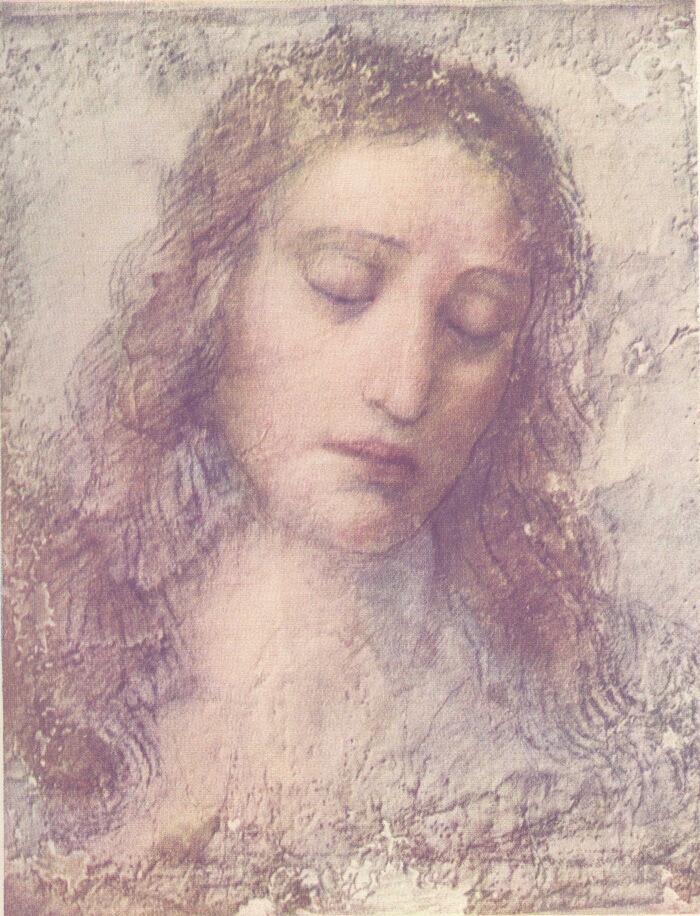
[PLATE VI.—THE HEAD OF CHRIST In the Brera Gallery, Milan. No. 280. 1 ft. 0-1/2 ins. by 1 ft. 4 ins. (0.32 x 0.40)]
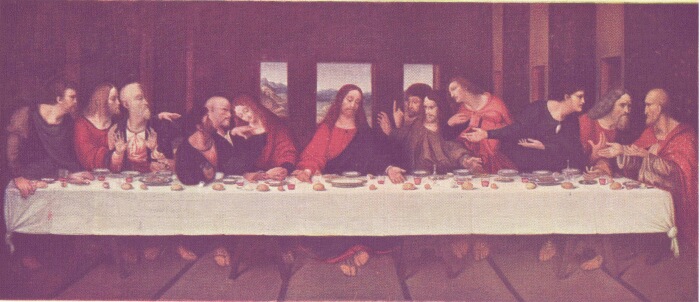
The copy of the "Last Supper" (Plate V.) by Marco d'Oggiono,
now in
the Diploma Gallery at Burlington House, was made shortly after
the
original painting was completed. It gives but a faint echo of
that
sublime work "in which the ideal and the real were blended in
perfect
unity." This copy was long in the possession of the Carthusians
in
their Convent at Pavia, and, on the suppression of that Order
and
the sale of their effects in 1793, passed into the possession of
a
grocer at Milan. It was subsequently purchased for £600 by
the Royal
Academy on the advice of Sir Thomas Lawrence, who left no
stone
unturned to acquire also the original studies for the heads of
the
Apostles. Some of these in red and black chalk are now
preserved
in the Royal Library at Windsor, where there are in all 145
drawings
by Leonardo.
Several other old copies of the fresco exist, notably the one
in the
Louvre. Francis I. wished to remove the whole wall of the
Refectory to
Paris, but he was persuaded that that would be impossible;
the
Constable de Montmorency then had a copy made for the Chapel of
the
Château d'Ecouen, whence it ultimately passed to the
Louvre.
The singularly beautiful "Head of Christ" (Plate VI.), now in
the
Brera Gallery at Milan, is the original study for the head of
the
principal figure in the fresco painting of the "Last Supper."
In
spite of decay and restoration it expresses "the most
elevated
seriousness together with Divine Gentleness, pain on account
of
the faithlessness of His disciples, a full presentiment of His
own
death, and resignation to the will of His Father."
Ludovico, to whom Leonardo was now court-painter, had married
Beatrice
d'Este, in 1491, when she was only fifteen years of age. The
young
Duchess, who at one time owned as many as eighty-four splendid
gowns,
refused to wear a certain dress of woven gold, which her husband
had
given her, if Cecilia Gallerani, the Sappho of her day, continued
to
wear a very similar one, which presumably had been given to her
by
Ludovico. Having discarded Cecilia, who, as her tastes did not
lie in
the direction of the Convent, was married in 1491 to Count
Ludovico
Bergamini, the Duke in 1496 became enamoured of Lucrezia
Crivelli, a
lady-in-waiting to the Duchess Beatrice.
Leonardo, as court painter, perhaps painted a portrait, now
lost, of
Lucrezia, whose features are more likely to be preserved to us in
the
portrait by Ambrogio da Predis, now in the Collection of the Earl
of
Roden, than in the quite unauthenticated portrait (Plate VII.),
now in
the Louvre (No. 1600).
On January 2, 1497, Beatrice spent three hours in prayer in
the church
of St. Maria delle Grazie, and the same night gave birth to a
stillborn child. In a few hours she passed away, and from that
moment
Ludovico was a changed man. He went daily to see her tomb, and
was
quite overcome with grief.
In April 1498, Isabella d'Este, Beatrice's elder, more
beautiful, and
more graceful sister, "at the sound of whose name all the muses
rise
and do reverence" wrote to Cecilia Gallerani, or Bergamini,
asking her
to lend her the portrait which Leonardo had painted of her
some
fifteen years earlier, as she wished to compare it with a picture
by
Giovanni Bellini. Cecilia graciously lent the picture—now
presumably
lost—adding her regret that it no longer resembled her.
Among the last of Leonardo da Vinci's works in Milan towards
the end
of 1499 was, probably, the superb cartoon of "The Virgin and
Child
with St. Anne and St. John," now at Burlington House. Though
little
known to the general public, this large drawing on _carton_,
or
stiff paper, is one of the greatest of London's treasures, as
it
reveals the sweeping line of Leonardo's powerful draughtsmanship.
It
was in the Pompeo Leoni, Arconati, Casnedi, and Udney
Collections
before passing to the Royal Academy.
In 1499 the stormy times in Milan foreboded the end of
Ludovico's
reign. In April of that year we read of his giving a vineyard
to
Leonardo; in September Ludovico had to leave Milan for the Tyrol
to
raise an army, and on the 14th of the same month the city was
sold by
Bernardino di Corte to the French, who occupied it from 1500 to
1512.
Ludovico may well have had in mind the figure of the traitor in
the
"Last Supper" when he declared that "Since the days of Judas
Iscariot
there has never been so black a traitor as Bernardino di Corte."
On
October 6th Louis XII. entered the city. Before the end of the
year
Leonardo, realising the necessity for his speedy departure, sent
six
hundred gold florins by letter of exchange to Florence to be
placed
to his credit with the hospital of S. Maria Nuova.
In the following year, Ludovico having been defeated at
Novara,
Leonardo was a homeless wanderer. He left Milan for Mantua, where
he
drew a portrait in chalk of Isabella d'Este, which is now in
the
Louvre. Leonardo eventually arrived in Florence about Easter
1500.
After apparently working there in 1501 on a second Cartoon,
similar in
most respects to the one he had executed in Milan two years
earlier,
he travelled in Umbria, visiting Orvieto, Pesaro, Rimini, and
other
towns, acting as engineer and architect to Cesare Borgia, for
whom he
planned a navigable canal between Cesena and Porto
Cese-natico.
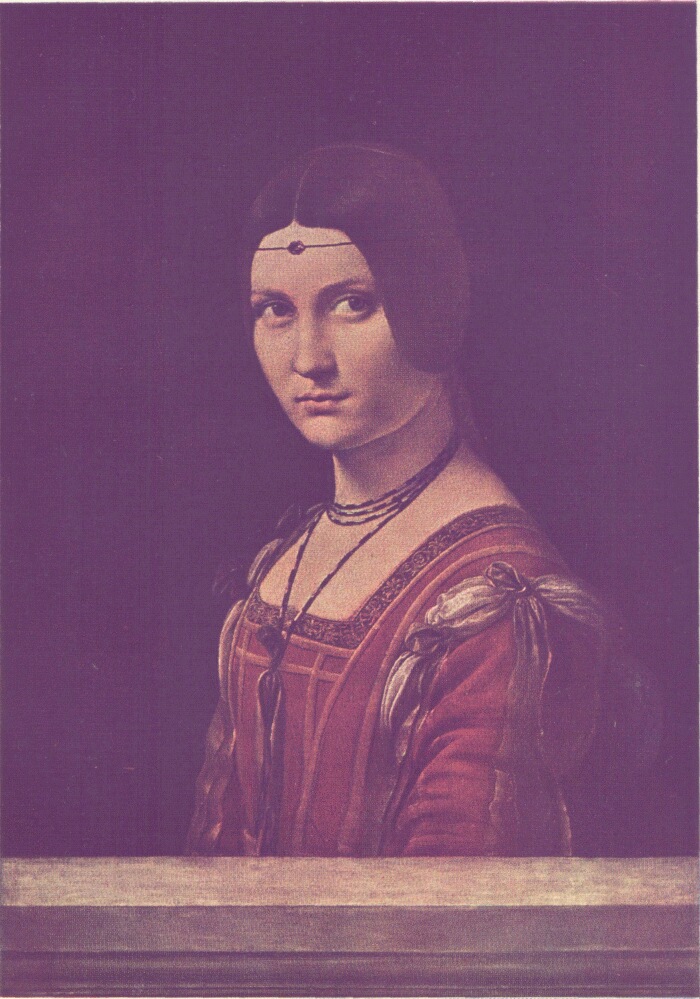
[PLATE VII.-PORTRAIT (PRESUMED) OF LUCREZIA CRIVELLI In the Louvre. No. 1600 [483]. 2 ft by I ft 5 ins. (0.62 x 0.44) This picture, although officially attributed to Leonardo, is probably not by him, and almost certainly does not represent Lucrezia Crivelli. It was once known as a "Portrait of a Lady" and is still occasionally miscalled "La Belle Féronnière."]

Early in 1503 he was back again in Florence, and set to work
in
earnest on the "Portrait of Mona Lisa" (Plate I.), now in the
Louvre
(No. 1601). Lisa di Anton Maria di Noldo Gherardini was the
daughter
of Antonio Gherardini. In 1495 she married Francesco di
Bartolommeo de
Zenobi del Giocondo. It is from the surname of her husband that
she
derives the name of "La Joconde," by which her portrait is
officially
known in the Louvre. Vasari is probably inaccurate in saying
that
Leonardo "loitered over it for four years, and finally left
it
unfinished." He may have begun it in the spring of 1501 and,
probably
owing to having taken service under Cesare Borgia in the
following
year, put it on one side, ultimately completing it after working
on
the "Battle of Anghiari" in 1504. Vasari's eulogy of this
portrait may
with advantage be quoted: "Whoever shall desire to see how far
art can
imitate nature may do so to perfection in this head, wherein
every
peculiarity that could be depicted by the utmost subtlety of
the
pencil has been faithfully reproduced. The eyes have the
lustrous
brightness and moisture which is seen in life, and around them
are
those pale, red, and slightly livid circles, also proper to
nature.
The nose, with its beautiful and delicately roseate nostrils,
might be
easily believed to be alive; the mouth, admirable in its outline,
has
the lips uniting the rose-tints of their colour with those of
the
face, in the utmost perfection, and the carnation of the cheek
does
not appear to be painted, but truly flesh and blood. He who
looks
earnestly at the pit of the throat cannot but believe that he
sees the
beating of the pulses. Mona Lisa was exceedingly beautiful, and
while
Leonardo was painting her portrait, he took the precaution of
keeping
some one constantly near her to sing or play on instruments, or
to
jest and otherwise amuse her."
Leonardo painted this picture in the full maturity of his
talent, and,
although it is now little more than a monochrome owing to the
free and
merciless restoration to which it has been at times subjected, it
must
have created a wonderful impression on those who saw it in the
early
years of the sixteenth century. It is difficult for the
unpractised
eye to-day to form any idea of its original beauty. Leonardo has
here
painted this worldly-minded woman—her portrait is much more
famous
than she herself ever was—with a marvellous charm and suavity,
a
finesse of expression never reached before and hardly ever
equalled
since. Contrast the head of the Christ at Milan, Leonardo's
conception
of divinity expressed in perfect humanity, with the subtle
and
sphinx-like smile of this languorous creature.
The landscape background, against which Mona Lisa is posed,
recalls
the severe, rather than exuberant, landscape and the dim vistas
of
mountain ranges seen in the neighbourhood of his own birthplace.
The
portrait was bought during the reign of Francis I. for a sum
which is
to-day equal to about £1800. Leonardo, by the way, does not
seem to
have been really affected by any individual affection for any
woman,
and, like Michelangelo and Raphael, never married.
In January 4, 1504, Leonardo was one of the members of the
Committee
of Artists summoned to advise the Signoria as to the most
suitable
site for the erection of Michelangelo's statue of "David," which
had
recently been completed.
In the following May he was commissioned by the Signoria to
decorate
one of the walls of the Council Hall of the Palazzo Vecchio.
The
subject he selected was the "Battle of Anghiari." Although he
completed the cartoon, the only part of the composition which
he
eventually executed in colour was an incident in the
foreground
which dealt with the "Battle of the Standard." One of the
many
supposed copies of a study of this mural painting now hangs on
the
south-east staircase in the Victoria and Albert Museum. It
depicts the
Florentines under Cardinal Ludovico Mezzarota Scarampo
fighting
against the Milanese under Niccolò Piccinino, the General
of Filippo
Maria Visconti, on June 29, 1440.
Leonardo was back in Milan in May 1506 in the service of the
French
King, for whom he executed, apparently with the help of
assistants,
"the Madonna, the Infant Christ, and Saint Anne" (Plate VIII.).
The
composition of this oil-painting seems to have been built up on
the
second cartoon, which he had made some eight years earlier, and
which
was apparently taken to France in 1516 and ultimately lost.
From 1513-1515 he was in Rome, where Giovanni de' Medici had
been
elected Pope under the title of Leo X. He did not, however, work
for
the Pope, although he resided in the Vatican, his time being
occupied
in studying acoustics, anatomy, optics, geology, minerals,
engineering, and geometry!
At last in 1516, three years before his death, Leonardo left
his
native land for France, where he received from Francis I. a
princely
income. His powers, however, had already begun to fail, and
he
produced very little in the country of his adoption. It is,
nevertheless, only in the Louvre that his achievements as a
painter
can to-day be adequately studied.
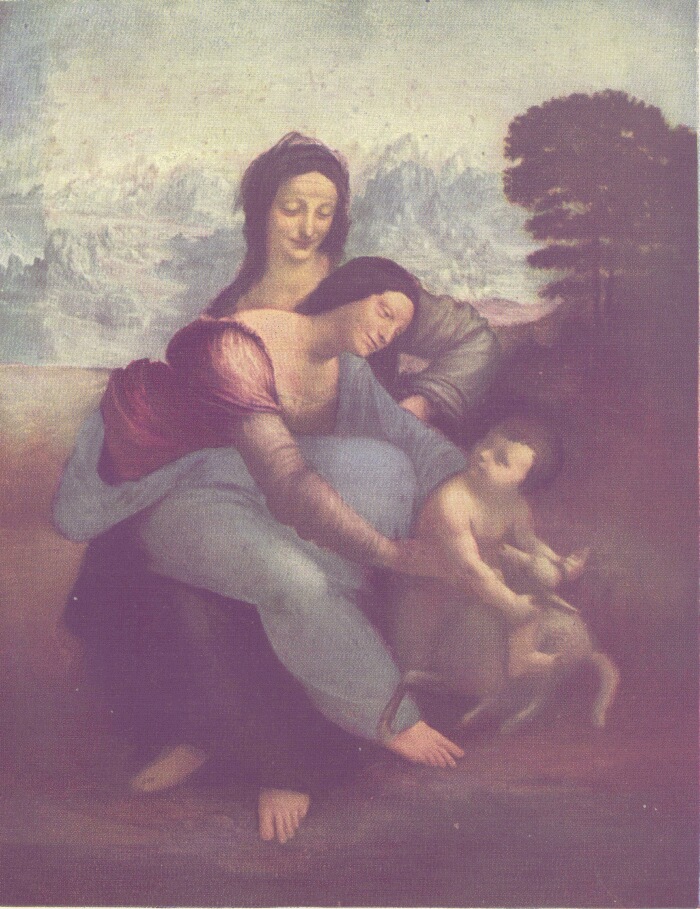
[PLATE VIII.-MADONNA, INFANT CHRIST, AND ST. ANNE In the Louvre. No. 1508. 5 ft. 7 in. h. by 4 ft. 3 in. w. (1.70 x 1.29) Painted between 1509 and 1516 with the help of assistants.]
On October 10, 1516, when he was resident at the Manor House
of Cloux
near Amboise in Touraine with Francesco Melzi, his friend and
assistant, he showed three of his pictures to the Cardinal of
Aragon,
but his right hand was now paralysed, and he could "no longer
colour
with that sweetness with which he was wont, although still able
to
make drawings and to teach others."
It was no doubt in these closing years of his life that he
drew the
"Portrait of Himself" in red chalk, now at Turin, which is
probably
the only authentic portrait of him in existence.
On April 23, 1519—Easter Eve—exactly forty-five years before
the
birth of Shakespeare, Leonardo da Vinci made his will, and on May
2 of
the same year he passed away.
Vasari informs us that Leonardo, "having become old, lay sick
for many
months, and finding himself near death and being sustained in the
arms
of his servants and friends, devoutly received the Holy
Sacrament. He
was then seized with a paroxysm, the forerunner of death, when
King
Francis I., who was accustomed frequently and affectionately to
visit
him, rose and supported his head to give him such assistance and
to do
him such favour as he could in the hope of alleviating his
sufferings.
The spirit of Leonardo, which was most divine, conscious that he
could
attain to no greater honour, departed in the arms of the
monarch,
being at that time in the seventy-fifth year of his age." The
not
over-veracious chronicler, however, is here drawing largely upon
his
imagination. Leonardo was only sixty-seven years of age, and the
King
was in all probability on that date at St. Germain-en Laye!
Thus died "Mr. Lionard de Vincy, the noble Milanese,
painter,
engineer, and architect to the King, State Mechanician" and
"former
Professor of Painting to the Duke of Milan."
"May God Almighty grant him His eternal peace," wrote his
friend and
assistant Francesco Melzi. "Every one laments the loss of a man
whose
like Nature cannot produce a second time."
Leonardo, whose birth antedates that of Michelangelo and
Raphael by
twenty three and thirty-one years respectively, was thus in
the
forefront of the Florentine Renaissance, his life coinciding
almost
exactly with the best period of Tuscan painting.
Leonardo was the first to investigate scientifically and to
apply to
art the laws of light and shade, though the preliminary
investigations
of Piero della Francesca deserve to be recorded.
He observed with strict accuracy the subtleties of
chiaroscuro—light
and shade apart from colour; but, as one critic has pointed out,
his
gift of chiaroscuro cost the colour-life of many a noble
picture.
Leonardo was "a tonist, not a colourist," before whom the whole
book
of nature lay open.
It was not instability of character but versatility of mind
which
caused him to undertake many things that having commenced he
afterwards abandoned, and the probability is that as soon as he
saw
exactly how he could solve any difficulty which presented itself,
he
put on one side the merely perfunctory execution of such a
task.
In the Forster collection in the Victoria and Albert museum
three of
Leonardo's note-books with sketches are preserved, and it is
stated
that it was his practice to carry about with him, attached to
his
girdle, a little book for making sketches. They prove that he
was
left-handed and wrote from right to left.
We can readily believe the statements of Benvenuto Cellini,
the
sixteenth-century Goldsmith, that Francis I. "did not believe
that any other man had come into the world who had attained so
great a
knowledge as Leonardo, and that not only as sculptor, painter,
and
architect, for beyond that he was a profound philosopher." It
was
Cellini also who contended that "Leonardo da Vinci, Michelangelo,
and
Raphael are the Book of the World."
Leonardo anticipated many eminent scientists and inventors in
the
methods of investigation which they adopted to solve the many
problems
with which their names are coupled. Among these may be cited
Copernicus' theory of the earth's movement, Lamarck's
classification
of vertebrate and invertebrate animals, the laws of friction,
the laws of combustion and respiration, the elevation of the
continents, the laws of gravitation, the undulatory theory of
light
and heat, steam as a motive power in navigation, flying machines,
the
invention of the camera obscura, magnetic attraction, the use of
the
stone saw, the system of canalisation, breech loading cannon,
the
construction of fortifications, the circulation of the blood,
the
swimming belt, the wheelbarrow, the composition of explosives,
the
invention of paddle wheels, the smoke stack, the mincing machine!
It
is, therefore, easy to see why he called "Mechanics the
Paradise
of the Sciences."
Leonardo was a SUPERMAN.
The eye is the window of the soul.
Tears come from the heart and not from the brain.
The natural desire of good men is knowledge.
A beautiful body perishes, but a work of art dies not.
Every difficulty can be overcome by effort.
Time abides long enough for those who make use of it.
Miserable men, how often do you enslave yourselves
to gain money!
The influence of Leonardo was strongly felt in Milan, where he
spent
so many of the best years of his life and founded a School of
painting. He was a close observer of the gradation and reflex
of
light, and was capable of giving to his discoveries a practical
and
aesthetic form. His strong personal character and the fascination
of
his genius enthralled his followers, who were satisfied to repeat
his
types, to perpetuate the "grey-hound eye," and to make use of
his
little devices. Among this group of painters may be mentioned
Boltraffio, who perhaps painted the "Presumed Portrait of
Lucrezia
Crivelli" (Plate VII.), which is officially attributed in the
Louvre
to the great master himself.
Signor Uzielli has shown that one Tommaso da Vinci, a
descendant of
Domenico (one of Leonardo's brothers), was a few years ago a
peasant
at Bottinacio near Montespertoli, and had then in his possession
the
family papers, which now form part of the archives of the
Accademia
dei Lincei at Rome. It was proved also that Tommaso had given
his
eldest son "the glorious name of Leonardo."

End of Project Gutenberg's Leonardo da Vinci, by Maurice W. Brockwell
*** END OF THE PROJECT GUTENBERG EBOOK LEONARDO DA VINCI ***
This file should be named 8ldvn10h.htm or 8ldvn10h.zip
Corrected EDITIONS of our eBooks get a new NUMBER, 8ldvn11h.htm
VERSIONS based on separate sources get new LETTER, 8ldvn10ah.htm
Produced by Juliet Sutherland, David Widger and the DP Team
Project Gutenberg eBooks are often created from several printed
editions, all of which are confirmed as Public Domain in the US
unless a copyright notice is included. Thus, we usually do not
keep eBooks in compliance with any particular paper edition.
We are now trying to release all our eBooks one year in advance
of the official release dates, leaving time for better editing.
Please be encouraged to tell us about any error or corrections,
even years after the official publication date.
Please note neither this listing nor its contents are final til
midnight of the last day of the month of any such announcement.
The official release date of all Project Gutenberg eBooks is at
Midnight, Central Time, of the last day of the stated month. A
preliminary version may often be posted for suggestion, comment
and editing by those who wish to do so.
Most people start at our Web sites at:
http://gutenberg.net or
http://promo.net/pg
These Web sites include award-winning information about Project
Gutenberg, including how to donate, how to help produce our new
eBooks, and how to subscribe to our email newsletter (free!).
Those of you who want to download any eBook before announcement
can get to them as follows, and just download by date. This is
also a good way to get them instantly upon announcement, as the
indexes our cataloguers produce obviously take a while after an
announcement goes out in the Project Gutenberg Newsletter.
http://www.ibiblio.org/gutenberg/etext03 or
ftp://ftp.ibiblio.org/pub/docs/books/gutenberg/etext03
Or /etext02, 01, 00, 99, 98, 97, 96, 95, 94, 93, 92, 92, 91 or 90
Just search by the first five letters of the filename you want,
as it appears in our Newsletters.
Information about Project Gutenberg (one page)
We produce about two million dollars for each hour we work. The
time it takes us, a rather conservative estimate, is fifty hours
to get any eBook selected, entered, proofread, edited, copyright
searched and analyzed, the copyright letters written, etc. Our
projected audience is one hundred million readers. If the value
per text is nominally estimated at one dollar then we produce $2
million dollars per hour in 2002 as we release over 100 new text
files per month: 1240 more eBooks in 2001 for a total of 4000+
We are already on our way to trying for 2000 more eBooks in 2002
If they reach just 1-2% of the world's population then the total
will reach over half a trillion eBooks given away by year's end.
The Goal of Project Gutenberg is to Give Away 1 Trillion eBooks!
This is ten thousand titles each to one hundred million readers,
which is only about 4% of the present number of computer users.
Here is the briefest record of our progress (* means estimated):
eBooks Year Month
1 1971 July
10 1991 January
100 1994 January
1000 1997 August
1500 1998 October
2000 1999 December
2500 2000 December
3000 2001 November
4000 2001 October/November
6000 2002 December*
9000 2003 November*
10000 2004 January*
The Project Gutenberg Literary Archive Foundation has been created
to secure a future for Project Gutenberg into the next millennium.
We need your donations more than ever!
As of February, 2002, contributions are being solicited from people
and organizations in: Alabama, Alaska, Arkansas, Connecticut,
Delaware, District of Columbia, Florida, Georgia, Hawaii, Illinois,
Indiana, Iowa, Kansas, Kentucky, Louisiana, Maine, Massachusetts,
Michigan, Mississippi, Missouri, Montana, Nebraska, Nevada, New
Hampshire, New Jersey, New Mexico, New York, North Carolina, Ohio,
Oklahoma, Oregon, Pennsylvania, Rhode Island, South Carolina, South
Dakota, Tennessee, Texas, Utah, Vermont, Virginia, Washington, West
Virginia, Wisconsin, and Wyoming.
We have filed in all 50 states now, but these are the only ones
that have responded.
As the requirements for other states are met, additions to this list
will be made and fund raising will begin in the additional states.
Please feel free to ask to check the status of your state.
In answer to various questions we have received on this:
We are constantly working on finishing the paperwork to legally
request donations in all 50 states. If your state is not listed and
you would like to know if we have added it since the list you have,
just ask.
While we cannot solicit donations from people in states where we are
not yet registered, we know of no prohibition against accepting
donations from donors in these states who approach us with an offer to
donate.
International donations are accepted, but we don't know ANYTHING about
how to make them tax-deductible, or even if they CAN be made
deductible, and don't have the staff to handle it even if there are
ways.
Donations by check or money order may be sent to:
Project Gutenberg Literary Archive Foundation
PMB 113
1739 University Ave.
Oxford, MS 38655-4109
Contact us if you want to arrange for a wire transfer or payment
method other than by check or money order.
The Project Gutenberg Literary Archive Foundation has been approved by
the US Internal Revenue Service as a 501(c)(3) organization with EIN
[Employee Identification Number] 64-622154. Donations are
tax-deductible to the maximum extent permitted by law. As fund-raising
requirements for other states are met, additions to this list will be
made and fund-raising will begin in the additional states.
We need your donations more than ever!
You can get up to date donation information online at:
http://www.gutenberg.net/donation.html
***
If you can't reach Project Gutenberg,
you can always email directly to:
Michael S. Hart hart@pobox.com
Prof. Hart will answer or forward your message.
We would prefer to send you information by email.
**The Legal Small Print**
(Three Pages)
***START**THE SMALL PRINT!**FOR PUBLIC DOMAIN EBOOKS**START***
Why is this "Small Print!" statement here? You know: lawyers.
They tell us you might sue us if there is something wrong with
your copy of this eBook, even if you got it for free from
someone other than us, and even if what's wrong is not our
fault. So, among other things, this "Small Print!" statement
disclaims most of our liability to you. It also tells you how
you may distribute copies of this eBook if you want to.
*BEFORE!* YOU USE OR READ THIS EBOOK
By using or reading any part of this PROJECT GUTENBERG-tm
eBook, you indicate that you understand, agree to and accept
this "Small Print!" statement. If you do not, you can receive
a refund of the money (if any) you paid for this eBook by
sending a request within 30 days of receiving it to the person
you got it from. If you received this eBook on a physical
medium (such as a disk), you must return it with your request.
ABOUT PROJECT GUTENBERG-TM EBOOKS
This PROJECT GUTENBERG-tm eBook, like most PROJECT GUTENBERG-tm eBooks,
is a "public domain" work distributed by Professor Michael S. Hart
through the Project Gutenberg Association (the "Project").
Among other things, this means that no one owns a United States copyright
on or for this work, so the Project (and you!) can copy and
distribute it in the United States without permission and
without paying copyright royalties. Special rules, set forth
below, apply if you wish to copy and distribute this eBook
under the "PROJECT GUTENBERG" trademark.
Please do not use the "PROJECT GUTENBERG" trademark to market
any commercial products without permission.
To create these eBooks, the Project expends considerable
efforts to identify, transcribe and proofread public domain
works. Despite these efforts, the Project's eBooks and any
medium they may be on may contain "Defects". Among other
things, Defects may take the form of incomplete, inaccurate or
corrupt data, transcription errors, a copyright or other
intellectual property infringement, a defective or damaged
disk or other eBook medium, a computer virus, or computer
codes that damage or cannot be read by your equipment.
LIMITED WARRANTY; DISCLAIMER OF DAMAGES
But for the "Right of Replacement or Refund" described below,
[1] Michael Hart and the Foundation (and any other party you may
receive this eBook from as a PROJECT GUTENBERG-tm eBook) disclaims
all liability to you for damages, costs and expenses, including
legal fees, and [2] YOU HAVE NO REMEDIES FOR NEGLIGENCE OR
UNDER STRICT LIABILITY, OR FOR BREACH OF WARRANTY OR CONTRACT,
INCLUDING BUT NOT LIMITED TO INDIRECT, CONSEQUENTIAL, PUNITIVE
OR INCIDENTAL DAMAGES, EVEN IF YOU GIVE NOTICE OF THE
POSSIBILITY OF SUCH DAMAGES.
If you discover a Defect in this eBook within 90 days of
receiving it, you can receive a refund of the money (if any)
you paid for it by sending an explanatory note within that
time to the person you received it from. If you received it
on a physical medium, you must return it with your note, and
such person may choose to alternatively give you a replacement
copy. If you received it electronically, such person may
choose to alternatively give you a second opportunity to
receive it electronically.
THIS EBOOK IS OTHERWISE PROVIDED TO YOU "AS-IS". NO OTHER
WARRANTIES OF ANY KIND, EXPRESS OR IMPLIED, ARE MADE TO YOU AS
TO THE EBOOK OR ANY MEDIUM IT MAY BE ON, INCLUDING BUT NOT
LIMITED TO WARRANTIES OF MERCHANTABILITY OR FITNESS FOR A
PARTICULAR PURPOSE.
Some states do not allow disclaimers of implied warranties or
the exclusion or limitation of consequential damages, so the
above disclaimers and exclusions may not apply to you, and you
may have other legal rights.
INDEMNITY
You will indemnify and hold Michael Hart, the Foundation,
and its trustees and agents, and any volunteers associated
with the production and distribution of Project Gutenberg-tm
texts harmless, from all liability, cost and expense, including
legal fees, that arise directly or indirectly from any of the
following that you do or cause: [1] distribution of this eBook,
[2] alteration, modification, or addition to the eBook,
or [3] any Defect.
DISTRIBUTION UNDER "PROJECT GUTENBERG-tm"
You may distribute copies of this eBook electronically, or by
disk, book or any other medium if you either delete this
"Small Print!" and all other references to Project Gutenberg,
or:
[1] Only give exact copies of it. Among other things, this
requires that you do not remove, alter or modify the
eBook or this "small print!" statement. You may however,
if you wish, distribute this eBook in machine readable
binary, compressed, mark-up, or proprietary form,
including any form resulting from conversion by word
processing or hypertext software, but only so long as
*EITHER*:
[*] The eBook, when displayed, is clearly readable, and
does *not* contain characters other than those
intended by the author of the work, although tilde
(~), asterisk (*) and underline (_) characters may
be used to convey punctuation intended by the
author, and additional characters may be used to
indicate hypertext links; OR
[*] The eBook may be readily converted by the reader at
no expense into plain ASCII, EBCDIC or equivalent
form by the program that displays the eBook (as is
the case, for instance, with most word processors);
OR
[*] You provide, or agree to also provide on request at
no additional cost, fee or expense, a copy of the
eBook in its original plain ASCII form (or in EBCDIC
or other equivalent proprietary form).
[2] Honor the eBook refund and replacement provisions of this
"Small Print!" statement.
[3] Pay a trademark license fee to the Foundation of 20% of the
gross profits you derive calculated using the method you
already use to calculate your applicable taxes. If you
don't derive profits, no royalty is due. Royalties are
payable to "Project Gutenberg Literary Archive Foundation"
the 60 days following each date you prepare (or were
legally required to prepare) your annual (or equivalent
periodic) tax return. Please contact us beforehand to
let us know your plans and to work out the details.
WHAT IF YOU *WANT* TO SEND MONEY EVEN IF YOU DON'T HAVE TO?
Project Gutenberg is dedicated to increasing the number of
public domain and licensed works that can be freely distributed
in machine readable form.
The Project gratefully accepts contributions of money, time,
public domain materials, or royalty free copyright licenses.
Money should be paid to the:
"Project Gutenberg Literary Archive Foundation."
If you are interested in contributing scanning equipment or
software or other items, please contact Michael Hart at:
hart@pobox.com
[Portions of this eBook's header and trailer may be reprinted only
when distributed free of all fees. Copyright (C) 2001, 2002 by
Michael S. Hart. Project Gutenberg is a TradeMark and may not be
used in any sales of Project Gutenberg eBooks or other materials be
they hardware or software or any other related product without
express permission.]
*END THE SMALL PRINT! FOR PUBLIC DOMAIN EBOOKS*Ver.02/11/02*END*